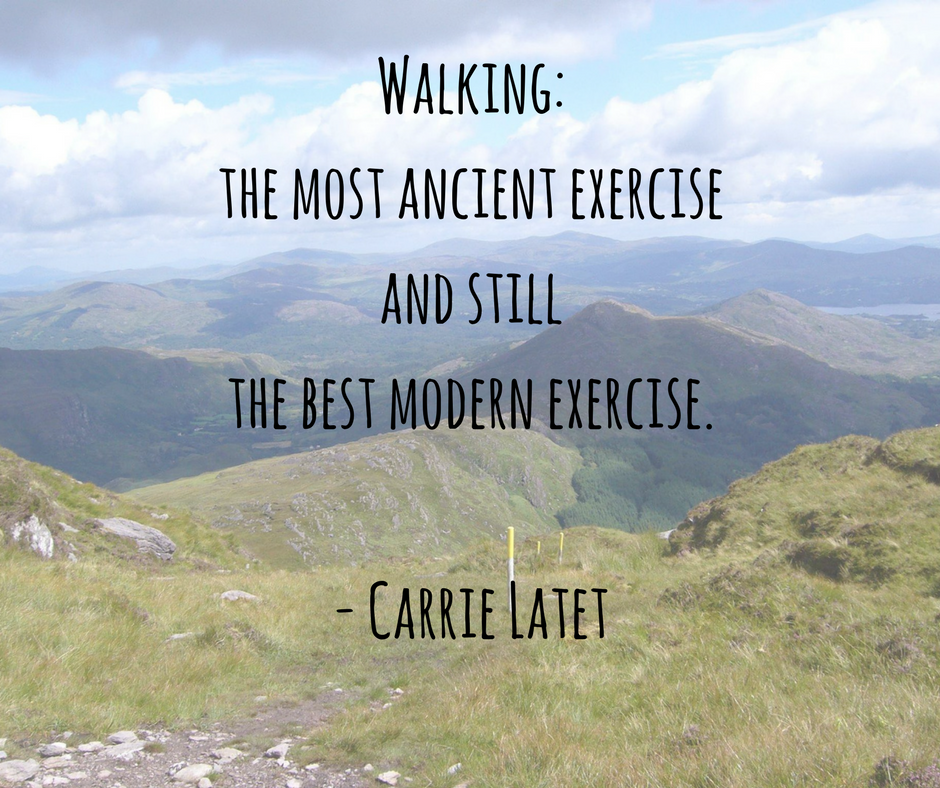Happy Friday, LoW!
“Everywhere is walking distance if you have the time.”
― Steven Wright
I love this quote because it’s so true. Walking is the most basic form of human movement yet it is often overshadowed by, well, almost everything. We do it so frequently that we don’t even think about it, but it is a fundamental aspect of being human. I love going for a walk. I can connect with nature, burn off some energy, digest my dinner, calm my hyperactive thoughts, and enjoy time with a friend all at the same time. Dan and I have also learned it’s great for brainstorming as one or both of us is often out walking during our phone calls.
Walking connects us to ourselves and our ancestors.
Long-ago humans used to walk more miles in a day that most of us walk in a week, or even a month! It was the only mode of transportation and they had to carry everything with them, including heavy hide clothing and weapons for hunting. Many early humnas were nomadic, following the seasonal movements of the animals that sustained them. They walked, just like the animals. It is largely our ability to walk that defines us as humans.
When I was a kid, I used to clip on my Walkman and walk until the batteries died. I had to sell all my Girl Scout cookies on foot. Our family often went for walks together and I’d also walk with friends to help solve the troubles of the world. Since there never seems to be a lack of worldly troubles, I highly recommend going for a walk to help sort them out.
Exploring the world around us by foot also increases our awareness of nature and our own bodies and thoughts. We miss so much when we zoom by in our cars. When my son was in preschool they used to take “sensory walks” which I have since adopted. Choose a sense and see what you notice. What do you hear when you listen closely? What do you smell? Does your body feel differently? There are so many opportunities to explore the world and ourselves when we simply take a walk.
Where can I walk?
Really the question is, where can’t you walk? In a pinch, you can walk circles around your yard or block. Take a walk through a neighborhood park. Here in Minnesota, many places encourage folks to make use of public indoor spaces like malls and colleges to get walking when the sidewalks are icy. You can walk around your office, walk to a cafe on your lunch break, walk to do your errands. One thing I enjoy is parking my car in a central location and walking for all my daily stops. I can hit up the post office, the grocery store, and several Little Free Libraries. There is no limit to the variety of places you can walk and opportunities you can find to get more steps in.
One thing to be cautious of is getting into a rut where you use the same route, the same direction, or the same surface, every time you walk. Utilizing different surfaces is good for your body and so is changing up the direction you travel. When you go for a walk in the snow or sand, it is a more challenging walking surface than dry cement. It forces your body to stabilize differently, which is a good thing! The same is true for the differences in walking on cement or grass or the forest floor. The more variation you have in your surfaces, the more opportunities your body gets to adapt. Try walking in grass, snow, hiking trails, sand, pebbles, and whatever else you can find. If you walk the same paved loop every day, try walking on the grass once in a while and doing the loop clockwise instead of counter-clockwise (or vice versa).
How to increase the challenge
If you have been a regular walker for a while, you might wonder how you can make the most of your walking time. There are things you can do to add challenge to your daily walks!
💪Carry something
Maybe you’re a parent and have to carry a toddler part way – you can carry them on your hip and alternate back and forth, you can carry them on your back or shoulders, or in a kid backpack. If you are hauling groceries, you can change up the weight balance of what is in each hand. Changing the way in which your body carries weight means your body has to adapt to a new challenge.
🎒Try rucking
Rucking is simply putting some weight in a backpack and going for a walk. You can use water bottles, books, a bag of flour, weights, or whatever works for you. Rucking got its start in the military as a way to train soldiers but it is accessible – and beneficial – to all of us. It adds a more difficult cardiovascular component as well as strength. You can ruck while you are walking to the library, taking your kids for a picnic at the park, hiking, at the mall, or wear it to do stair reps on your lunch break. You can even wear it for some of your workouts, such as rows on the pocket monkii!
🏔Add hills
Inclines and declines offer opportunities to strengthen our back chain muscles especially, such as our often underutilized glute muscles. Make sure on the descents that you don’t demand too much of your knees. If you flex your quads too much going downhill, your kneecap will pull into your femur bone, causing achy knees. I love this video explanation by none other than Katy Bowman for ways you can use your hips and pelvis to take some of the pressure off of your knees on descents.
👣Walk further
Consider tracking how far you are walking and adding a bit of distance weekly. If you are looking for a distance challenge, consider checking out the 12-Hour Walk in the resources below!
Walking is something we often take for granted, but is accessible to most of us. You can get up and walk no matter where you are, what you are wearing (if you have heels on you might just want to walk barefoot), or what your fitness level is. You can walk in your yard, in your office building, your neighborhood, at the park…the possibilities are endless. As usual, we strongly encourage you to get outside every day, and a walk is a great way to make that a priority. As John Muir said, “In every walk with nature one receives far more than he seeks.”
Resources
The 12 Hour Walk
I have not attempted this yet but some of our League of Wildness outdoor challenge members have! The book is really interesting and definitely has piqued my curiosity about a long walk.
First Steps: How Upright Walking Made Us Human
This is another book that I really enjoyed. It goes into the evolution and anthropology of humans, exploring exactly how we came to be two-legged upright walkers.
A YouTube podcast between Katy Bowman and Steven Sashen (CEO of Xero Shoes) about how to walk correctly. As with breathing you’d think this is something we do naturally, but like most other things our modern lives have also impacted how we walk and not in a positive way. We often have weak hips and glutes with tight hip flexors, all of which Katy dives into in the video.
I’m looking forward to hearing about where you walk this weekend. See if you can’t explore somewhere new on foot. Shoot me a note at kim@wildgym.com.
In walking wildness,
-Kim


Leave a comment
This site is protected by hCaptcha and the hCaptcha Privacy Policy and Terms of Service apply.